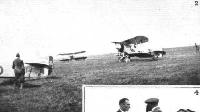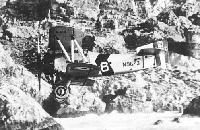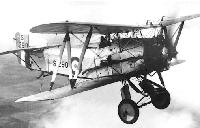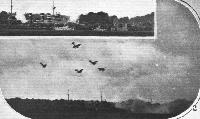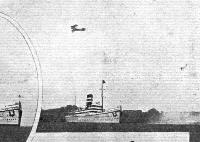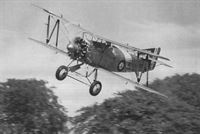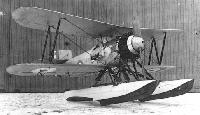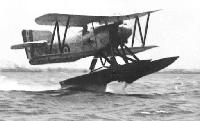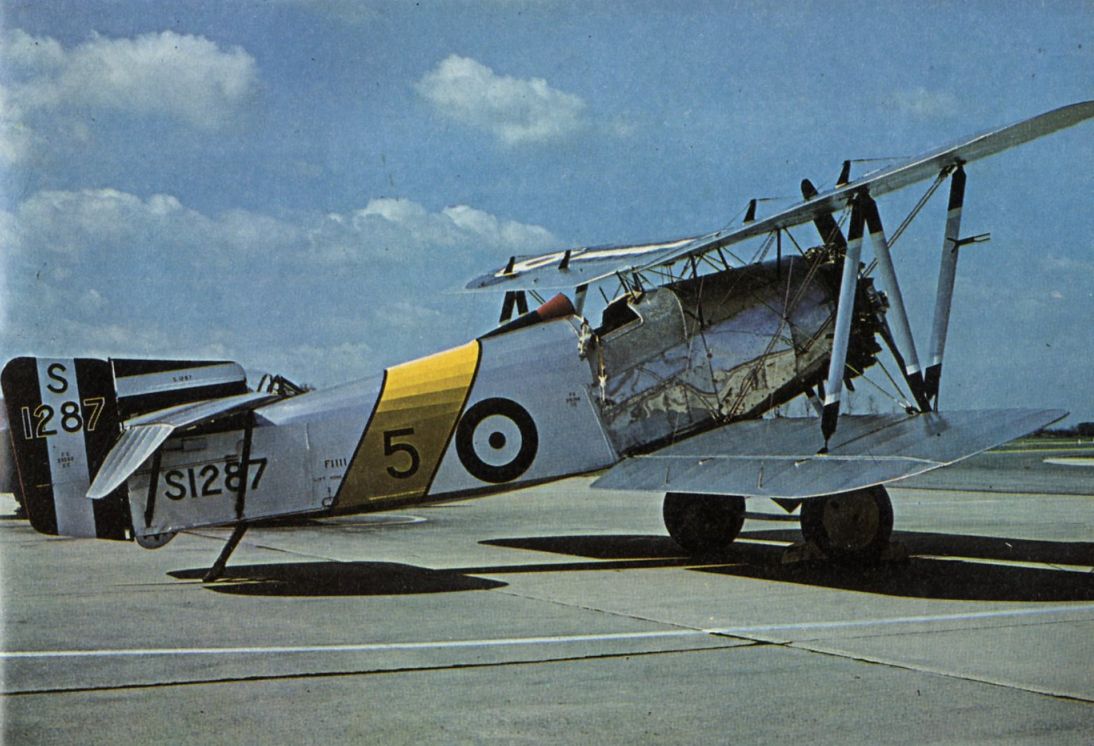
Описание
Страна : Великобритания
Год : 1922
Одноместный истребитель палубного базирования
Fairey Flycatcher I
В 1922 году Министерство авиации выпустило спецификацию 6/22 к морскому одноместному истребителю для замены Nieuport Nightjar корабельного базирования. В спецификации оговаривалась разработка вариантов с колесным и поплавковым шасси, а также амфибии. Силовая установка - двигатель воздушного охлаждения Bristol Jupiter или Armstrong Siddeley Jaguar. Для полномасштабной разработки отобрали два проекта - Fairey Flycatcher (переименован в Flycatcher I после появления Flycatcher II) и Parnall Plover, заказав постройку трех прототипов каждого, фирма "Parnall" позже построила десять серийных Plover, но, хотя этот самолет внешне выглядел привлекательнее угловатого Flycatcher I, в остальном машина уступала биплану "Fairey" и продержалась на службе в ВМС не более года.
Первый прототип Flycatcher I с 400-сильным мотором Jaguar II выполнил первый полет 28 ноября 1922 года в варианте аэродромного базирования, вскоре самолет переоснастили мотором Jupiter IV, с которым он принял участие в авиашоу британских ВВС в 1923 году. Второй прототип также получил мотор Jaguar II, но отличался от первого поплавковым шасси. Первый полет второй прототип выполнил в мае 1923 года. Третий прототип собрали в варианте амфибии. Подобно большинству самолетов "Fairey", на Flycatcher I для сокращения дистанции взлета и посадки был установлен механизм изменения развала стоек основных опор шасси - для посадки на авианосец самолету не требовались аэрофинишеры. Другим достоинством самолета, как самолета палубного, являлся небольшой размах крыла, за счет чего он помещался на подъемник без складывания плоскостей.
Первые серийные истребители поступили в 402-е звено авиации ВМС в 1923 году, а вскоре Flycatcher I заменили все самолеты более ранних типов, базировавшиеся на авианосцах и на линкорах (на башнях главного калибра нескольких линкоров имелись платформы для взлета и посадки аэропланов). Всего, с тремя прототипами, построили 196 самолетов. Flycatcher I состоял на вооружении авиации британских ВМС до 1934 года, когда последние самолеты 406-го звена из состава Восточно-индийской эскадрильи заменили на Hawker Osprey.
Внешне неуклюжий Flycatcher I был любим летчиками, в том числе благодаря прочной деревянно-металлической конструкции и мощному мотору. Даже с поплавковым шасси самолет отличался великолепной маневренностью. На экспорт Flycatcher I не поставлялся. Ни одного такого самолета не сохранилось, но в Британии построили пригодную к полетам полномасштабную реплику, оснащенную другим мотором. Реплика летала до 1996 года, когда ее передали в Музей авиации Королевских ВМС Великобритании.
Прототип морского истребителя Flycatcher II с мотором Jaguar выполнил первый полет в 1926 году. Позже на нем был установлен Bristol Mercury, но к этому времени Министерство авиации стало отдавать предпочтение истребителям с двигателями жидкостного охлаждения, поэтому работы по Flycatcher II прекратили. Самолет списали в мае 1929 года после отказа двигателя на взлете.
ТАКТИКО-ТЕХНИЧЕСКИЕ ХАРАКТЕРИСТИКИ
Fairey Flycatcher I (с колесным шасси)
Тип: одноместный истребитель палубного базирования
Силовая установка: один звездообразный мотор Armstrong Siddeley Jaguar III или IV мощностью 400 л. с. (298 кВт)
Летные характеристики: макс. скорость на высоте 1525 м - 216 км/ч; начальная скороподъемность 332 м; время набора высоты 3050 м – за 9 минут 29 секунд; практический потолок 5790 м; дальность 500 км
Масса: пустого 924 кг; максимальная взлетная 1372 кг
Размеры: размах крыльев 8,84 м; длина 7,01 м; высота 3,66 м; площадь крыльев 26,76 м2
Вооружение: два стреляющих вперед 7,7-мм пулемета Vickers по бортам носовой части фюзеляжа, до четырех 9-кг бомб на подвеске под нижним крылом
- Описание
Фотографии
-
Air Enthusiast 2007-01 / The Roundels File
Регистрационный номер: N9662 [2] Fairey Flycatcher N9662 '507' of 402 Flight, HMS 'Courageous', Eastern Mediterranean in 1932.
-
Air Enthusiast 2007-01 / The Roundels File
Регистрационный номер: N9676 Fairey Flycatcher N9676 '13' of 407 Flight, HMS 'COurageous', Malta in July 1928.
-
Air Enthusiast 2007-01 / The Roundels File
Регистрационный номер: N9680 [2] Fairey Flycatcher N9680 '1' of 401 Flight, HMS 'Argus', Atlantic Waters/Bay of Biscay in 1924/1925.
-
Air Enthusiast 2007-01 / The Roundels File
Регистрационный номер: N9960 Fairey Flycatcher N9960 '6' of 403 Flight, HMS 'Hermes', in the China Station in 1931.
-
Air Enthusiast 2007-01 / The Roundels File
Регистрационный номер: S1274 Fairey Flycatcher S1274 '527' of 401 Flight, HMS 'Furious', Western Mediterranean in early 1933.
-
Мировая Авиация 125
Регистрационный номер: S1278 [3] Flycatcher I с желто-голубыми полосами на фюзеляже и вертикальном оперении принадлежал командиру 405-го звена с авианосца
-
Air Enthusiast 2007-01 / The Roundels File
Регистрационный номер: S1279 Fairey Flycatcher S1279 '8' of 409 Flight, HMS 'Glorious' and Hal Far, Malta in early 1931. Plus top wing.
-
Aeroplane Monthly 1979-11
Регистрационный номер: S1287 [21] -
Aeroplane Monthly 1991-09 / J.Fairey - Flying the Flycatcher
Регистрационный номер: S1287 [21] RICHARD WINSLADE’S superb colour plate shows the author’s reproduction Fairey Flycatcher in the hands of John Romain up from its Duxford base in August 1990.
-
Aeroplane Monthly 1979-11
Регистрационный номер: S1287 [21] John Fairey's Fairey Flycatcher reproduction, G-BEYB/S1278, during its appearance at RNAS Yeovilton on August 1.
-
Aeroplane Monthly 1982-04 / J.Fairey - Flycatcher facsimile (2)
Регистрационный номер: S1287 [21] John Fairey's beautiful Fairey Flycatcher reproduction
-
Aeroplane Monthly 1982-04 / J.Fairey - Flycatcher facsimile (2)
Регистрационный номер: S1287 [21] The author flying the Flycatcher around Yeovilton on October 22, 1981. Pictures taken by RICHARD WILSON from an 815 Sqn Lynx.
-
Aeroplane Monthly 1998-12 / T.Harmsworth - Airshows: boom or bust? /The airshow business/
Регистрационный номер: S1287 [21] Heading off into the sunset. Show organisers consistently failed to book the Fairey Flycatcher replica despite its unique portrayal of 1920s fighter technology, and it is now retired from the scene forever.
-
Air Enthusiast 2007-01 / The Roundels File
Регистрационный номер: N163 [4] The prototype Flycatcher, N163, was first flown on November 28, 1922 from Hamble in the hands of Vincent Nicholl. It spent its life involved in testing and trials, and was still extant in 1925.
-
Flight 1929-07 / Flight
Регистрационный номер: N163 [4] FAIREY "FLYCATCHER": Single-seater Fleet-Fighter, with Armstrong Siddeley "Jaguar."
-
Aeroplane Monthly 1987-07 / A.Lumsden, T.Heffernan - Per Mare Probare (4)
Регистрационный номер: N163 [4] The first prototype Flycatcher, N163, was a landplane and was first flown on November 28, 1922 at Hamble.
-
Flight 1923-07 / Flight
Регистрационный номер: N163 [4] A NEW MACHINE AT THE R.A.F. PAGEANT: The Fairey "Flycatcher" ship's 'plane, fitted with a 400 h.p. Bristol "Jupiter."
-
Aviation Historian 37 / R.Lezon, M.Willis - Far-flung Flycatcher
Регистрационный номер: S1590 After its brief sojourn in Argentina, the original S1284 was returned to the UK and re-integrated into Royal Navy service as S1590, as seen in this rare photograph. Coded “513”, it was damaged in a collision with another Flycatcher in May 1932. After repair it went on to serve with No 801 Sqn, before disappearing into obscurity.
-
Air Enthusiast 2007-01 / The Roundels File
Регистрационный номер: N9943 [2] N9943 '549' of 405 Flight, HMS 'Glorious', circa mid-1932. Note the pennant attached to the upper aileron.
-
Air-Britain Aeromilitaria 1979-01
Регистрационный номер: N9943 [2] Flycatcher N9943 from No.405 Flight disembarked at Aboukir in 1929
Sqn Ldr C.J.D.Schofield has posed a pertinent comment on the photograph of N9943 on page 9 of AM.1/79. If it was taken in 1929, where did the Nimrod air cooler poking in from the left come from? The answer must be that the official caption is wrong and the date was probably 1932, just after Nimrods arrived in the Med Fleet and before the last Fly departed. -
Air Enthusiast 2007-01 / The Roundels File
Регистрационный номер: N9933 A wonderful line-up - place and time unknown. In the foreground is N9933 '10' of 405 Flight, attached to HMS 'Glorious'. This machine was with 405 by the summer of 1929.
-
Flight 1926-09 / Flight
NEWCASTLE AERO CLUB'S FIRST FLYING MEETING: Some "snaps" taken at Cramlington. Fairey "Flycatchers" from 406 Squadron (Fleet Fighter) visited the meeting and gave fine displays
-
Aviation Historian 37 / R.Lezon, M.Willis - Far-flung Flycatcher
The Flycatcher entered Royal Navy service with No 402 Flight in 1923, and became a popular item at flying displays because its Jaguar engine had short stub pipes from the exhaust valves and no collector ring - which, when added to the supersonic tips of its fixed-pitch Fairey-Reed metal propeller, created quite a noise in a dive.
-
Flight 1926-09 / Flight
NEWCASTLE AERO CLUB'S FIRST FLYING MEETING: Some "snaps" taken at Cramlington. Fairey "Flycatchers" from 406 Squadron (Fleet Fighter) visited the meeting and gave fine displays
-
Flight 1927-03 / Flight
Регистрационный номер: N9680 [2] Fairey "Flycatcher" (Armstrong Siddeley "Jaguar" or Bristol "Jupiter"). Nominally a single-seater fighter, the "Flycatcher" is adaptable for many roles. Its "cocked-up" fuselage arises from the necessity for a large ground angle, used in conjunction with the Fairey patented flap gear, which makes for slow landings with heavy loading. It functions as a ship's 'plane for naval co-operation, and is also produced as a twin-float seaplane, a design which makes it amphibian, too, for landing wheels project through the centre of the floats. It is used with Fleet Fighter Flights Nos. 401, 402, 403, 404, 405 and 406, on aircraft carriers and at coastal bases.
-
Flight 1930-05 / Flight
THE FLEET ABOVE: A Fairey Flycatcher (Jaguar engine) flying over Malta. Below can be seen the hangars of the seaplane station.
-
Air Enthusiast 2007-01 / The Roundels File
Регистрационный номер: N9673 [2] The pilot of N9673 of 402 Flight, attached to HMS 'Eagle' having fun around the Maltese coastline, circa 1929. Carrying the individual number '6', note that this has been repeated under the tip of the upper wing
-
Air Enthusiast 2007-01 / The Roundels File
Регистрационный номер: N9619 N9619 was delivered to Gosport, Hampshire, during the summer of 1924. Much of its time was spent on development flying, before ending up at the RAF Training Base Leuchars from 1928 - illustrated in late 1930 - and was still active in 1934.
-
Air-Britain Aeromilitaria 1983-01
Регистрационный номер: N9922, N9923, N9954 The trio of Fairey Flycatchers flying over the Mediterranean are N9923 (1), N9954 (7) and N9922 (5), all built in 1924. These single-seat carrier-borne fighters were also operated as seaplanes or amphibians. They were powered by a 400 h.p. Armstrong Siddeley Jaguar III or IV and were armed with two synchronised Vickers guns. There was also provision for four underwing mounted 20lb bombs. The Flycatcher became the standard FAA fighter for 10 yr until succeeded by Hawker Nimrods and Ospreys from 1934.
-
Air Enthusiast 2007-01 / The Roundels File
Регистрационный номер: S1290 S1290, showing its Fairey construction number - F.1114 - behind the serial number. Delivered to Gosport in January 1929, it served with the RAF Training Base Leuchars, Scotland, 1931 to 1933.
-
Aviation Historian 37 / R.Lezon, M.Willis - Far-flung Flycatcher
Регистрационный номер: N9928 [2] This classic study of Flycatcher N9928 by Charles E. Brown captures the curiously attractive essence of the type, despite its decidedly odd configuration. The metal forward section and the slightly upward-cranked wooden rear section, with its distinctive low-aspect-ratio fin, look as if they are parts of two different aeroplanes.
-
Air-Britain Aeromilitaria 1984-04
HMS Furious
-
Flight 1930-05 / Flight
A further selection from a cinema film, in this case showing a Flycatcher which landed and then got caught in a gust and slewed toward the ship's side before the landing crew had time to catch it; it was then righted, wheeled forward to the lift and sent down.
-
Flight 1930-05 / Flight
These three photographs also form a series, and are arranged to show the process of getting the aircraft down by the lift. These lifts are situated one forward and one aft of the flying deck, and are large enough to take the III F when the wings are half folded. The fighters can, of course, be lowered as they are, owing to their comparatively small span. The top photograph shows the Flycatcher being wheeled on to the lift. It should be noted that the wind-screens are raised both at the side and in the front. These screens are raised when the wind interferes with such work on the flying deck, and are lowered again when flying continues. In the second picture, the lift has gone down a little, and the size of the platform can be seen. The bottom photograph was taken from between decks, and shows the lift about half-way down with a Flycatcher on it coming down. Beneath the lift, and forward of it, are other machines of the flight which have already been housed in the hangar.
-
Flight 1932-05 / Flight
THE HORNET'S NEST: AN AERIAL VIEW OF THE AIRCRAFT CARRIER "COURAGEOUS." THE MACHINES RANGED ON THE FLYING DECK INCLUDE FAIREY "FLYCATCHERS" AND IIIF'S. NOTE THAT BOTH LIFTS ARE DOWN, PRESUMABLY TO FETCH MORE AIRCRAFT.
Другие самолёты на фотографии: Fairey Fairey IIIF - Великобритания - 1926
-
Air-Britain Aeromilitaria 1982-03
Argus in the late 1920s with a Flycatcher landing on. The 'T' marks the position of the retractable navigation bridge which lay flush with the flightdeck while flying was in progress. The lines of the original merchantile hull can be clearly seen. Palisades line the slides of the flightdeck and a steam wind indicator is fitted in the bows to ensure that the ship is headed directly into wind while landing on aircraft.
-
Air-Britain Aeromilitaria 1980-03
Регистрационный номер: S1287 [21] Three Fairey III F's and three Fairey Flycatchers lined up on the top flying deck. Here again one can get a good idea of the size of this deck, and can see that the landing and taking-off space available is considerably larger than many of the landing fields used by some of our joyriding firms who operate without a constant wind speed over their fields such as can be provided here at will.
Flycatcher S1287, upon which the author's reproduction is based, on HMS Glorious in January 1930.Другие самолёты на фотографии: Fairey Fairey IIIF - Великобритания - 1926
-
Aeroplane Monthly 1976-12 / Personal album
Регистрационный номер: N9662 [2] Our friend "Rupert" in trouble again, this time being retrieved after nearly going "over the end" in Fairey Flycatcher N9662, possibly with No 801 Squadron aboard HMS Courageous in 1930. The Flycatcher was a single-seat fighter powered by the 400 h.p. Armstrong Siddeley Jaguar IV radial engine. Note the camera gun on the starboard lower wing in this picture.
-
Air-Britain Aeromilitaria 1984-04
A Flycatcher parked behind the windbreak on the lower flying off deck. Note the exposed navigation and flying control positions which could trap an aircraft which swung on take-off
-
Air-Britain Aeromilitaria 1980-03
A slip flight Flycatcher takes off from the hangar deck
-
Flight 1930-05 / Flight
Регистрационный номер: S1280 [2] A Flycatcher just emerging from the upper hangar and starting to fly off. The distance required to take off can be gauged from the fact that in the top photograph the aircraft is just reaching the wind screen, while in the lower picture she has already well cleared it. When taking off in this fashion, the engines are, of course, run up in the hangar while the mechanics hold the aircraft back.
-
Aviation Historian 37 / R.Lezon, M.Willis - Far-flung Flycatcher
Регистрационный номер: S1280 [2] THE FAIREY "FLYCATCHER": This machine, variously fitted with "Jupiter" and "Jaguar" engines, is used extensively by the Fleet Air Arm. It has also been produced as a seaplane and as an amphibian.
The Fairey Flycatcher was the Royal Navy’s only fighter from 1924 until 1932, and proved extremely popular with its pilots, offering a compact, highly manoeuvrable and robust machine which could be easily adapted as a land plane, floatplane or amphibian. Here, S1280 of No 403 Flight takes off from HMS Glorious in 1930. -
Flight 1932-06 / Flight
Регистрационный номер: S1275 -
Flight 1930-05 / Flight
A Flycatcher taking off from the flying deck, just as it has cleared the forward windscreen, which can now be seen laid prone, and flush with the deck, thus allowing the aircraft to take off over it without damage to their wheels. Another point to notice in this photograph is the steam jet. This jet comes from a steam pipe which opens right in the bows of the ship, and it serves to tell the navigator when the ship is heading directly into wind; this he does by altering course until the steam is going aft over the deck parallel to the landing lines.
-
Flight 1930-05 / Flight
A Flycatcher is taking off
-
Air-Britain Aeromilitaria 1979-01
1 апреля 1924г.: в британских ВВС создана авиация флота, отвечающая за все палубные операции и действия гидропланов; воздушное наведение и разведка выполнялись экипажами ВМС, прикомандированными к ВВС, которые осуществляли общее руководство авиацией флота и предоставляли экипажи для выполнения различных летных задач. На снимке Fairey Flycatcher.
A Flycatcher lands on the wind-swept deck of HMS Courageous.
Dick Cronin points out that the photo depicting a Flycatcher landing (according to the original caption) is probably of a Flycatcher taking off - otherwise it would be well on the way to the lower flying off deck. The deck handlers would also have been in some jeopardy unless they had moved wery fast. -
Air-Britain Aeromilitaria 1983-01
Регистрационный номер: N9928 [2] Конструктивной особенностью фюзеляжа Flycatcher являлась возможность его быстрой разборки на элементы длиной не более 4,11 м. Авианосец на фотографии - "Игл".
The photo of a Flycatcher flying past 'Eagle' was taken by the late Charles E.Brown who died a few weeks before this issue was prepared. As with so many of his photographs, the timing is precise. No part of the aircraft obscures the carrier and even the planeguard destroyer in the background is beautifully positioned. -
Air-Britain Aeromilitaria 1979-02
The Flycatcher was the last Fleet Air Arm fighter to use flying-off platforms from cruisers and battleships before catapults became standard equipment on most ships larger than a light cruiser. Fleet No.13 is shown leaving a 'County' class heavy cruiser; the two heads beside the funnel apparently bowed in prayer are more probably looking into the viewfinders of their Box Brownies.
-
Air-Britain Aeromilitaria 1979-01
Flycatchers from No.405 Fleet Fighter Flight formate for photographs over Malta, base for most of her career of HMS Glorious. The aircraft involved are S1278 (7), S1281 (9), S1282 (10), S1283 (12) and S1286 (14). The codes are 'Fleet Numbers' and not, as in Royal Air Force squadrons, denote individual aircraft within one unit, which could cause duplication.
-
Air-Britain Aeromilitaria 1979-01
Регистрационный номер: S1278 [3], S1282 [2], S1286 [2] Flycatchers from No.405 Fleet Fighter Flight formate for photographs over Malta, base for most of her career of HMS Glorious. The aircraft involved are S1278 (7), S1281 (9), S1282 (10), S1283 (12) and S1286 (14). The codes are 'Fleet Numbers' and not, as in Royal Air Force squadrons, denote individual aircraft within one unit, which could cause duplication.
-
Air-Britain Aeromilitaria 1979-01
Регистрационный номер: S1278 [3], S1281, S1282 [2], S1283, S1286 [2] Fairey Flycatcher из 405-го звена над Мальтой.
Flycatchers from No.405 Fleet Fighter Flight formate for photographs over Malta, base for most of her career of HMS Glorious. The aircraft involved are S1278 (7), S1281 (9), S1282 (10), S1283 (12) and S1286 (14). The codes are 'Fleet Numbers' and not, as in Royal Air Force squadrons, denote individual aircraft within one unit, which could cause duplication. -
Air-Britain Aeromilitaria 1979-01
Flycatchers from No.405 Fleet Fighter Flight formate for photographs over Malta, base for most of her career of HMS Glorious. The aircraft involved are S1278 (7), S1281 (9), S1282 (10), S1283 (12) and S1286 (14). The codes are 'Fleet Numbers' and not, as in Royal Air Force squadrons, denote individual aircraft within one unit, which could cause duplication.
-
Flight 1925-07 / Flight
THE GRANDE FINALE AT THE R.A.F. DISPLAY: (2) Five Fairey "Flycatcher" Fleet Fighters arrive to the support of the "Seagull."
-
Flight 1929-07 / Flight
EVENT 14: AIR BATTLE AND SET PIECE: (2) "Flycatchers" oа the Fleet Fighter Squadron (No.405) open the attack with machine guns
-
Flight 1928-05 / Flight
HAMPSHIRE AIR PAGEANT: The Avro "Bison" descending after being defeated by the (distant) Fairey "Flycatcher" in the aerial combat.
Другие самолёты на фотографии: Avro Bison / Type 555 - Великобритания - 1921
-
Flight 1931-07 / Flight
A "FLYCATCHER" BOMBS THE CAMP.
-
Flight 1930-07 / Flight
Bombing an Encampment: A Flycatcher dropping its eggs.
-
Flight 1924-07 / Flight
THE R.A.F. PAGEANT: THE Event of the Day. British aircraft appearing on the scene are fired at with the "Slevic's" anti-aircraft guns, which are (on photo) silenced by a formation of Fairey "Flycatcher" fighters until a formation of Blackburn "Dart" torpedo-carriers discharge their torpedoes.
-
Flight 1930-07 / Flight
Strafing an Encampment: The Flycatcher zooms after dropping its bombs.
-
Aeroplane Monthly 1982-03 / J.Fairey - Flycatcher facsimile (1)
Регистрационный номер: S1287 [21] The author flying his Flycatcher at Old Warden on July 26, 1981.
-
Aeroplane Monthly 1982-04 / J.Fairey - Flycatcher facsimile (2)
Регистрационный номер: S1287 [21] The picture was taken during one of the author’s displays at Old Warden last year.
-
Aeroplane Monthly 1989-11 / C.Burkett - Born again. The Aircraft Restoration Company
Регистрационный номер: S1287 [21] ARC director and chief engineer John Romain flying Fairey Flycatcher replica G-BEYB/"S1287" in August. Built by John Fairey in 1977-79, G-BEYB is now maintained and operated by the ARC at Duxford.
-
Aeroplane Monthly 1982-03 / J.Fairey - Flycatcher facsimile (1)
Регистрационный номер: S1287 [21] -
Aeroplane Monthly 1982-03 / J.Fairey - Flycatcher facsimile (1)
Регистрационный номер: S1287 [21] -
Aeroplane Monthly 1982-04 / J.Fairey - Flycatcher facsimile (2)
Регистрационный номер: S1287 [21] -
Aeroplane Monthly 1991-09 / J.Fairey - Flying the Flycatcher
Регистрационный номер: S1287 [21] The Flycatcher’s unbalanced full-span ailerons make the biplane very heavy on lateral control.
-
Aeroplane Monthly 1991-09 / J.Fairey - Flying the Flycatcher
Регистрационный номер: S1287 [21] This dramatic view of the Flycatcher clearly shows the top wing dihedral and apparent anhedral on the lower wings.
-
Aeroplane Monthly 1983-11 / S.Piercey - The great warbirds display
John Fairey’s Fairey Flycatcher replica
-
Aeroplane Monthly 1986-01 / 1986 UK Aircraft Collections and Museums Guide
Регистрационный номер: S1287 [21] Fairey Flycatcher S1287.
-
Aeroplane Monthly 1982-04 / J.Fairey - Flycatcher facsimile (2)
Регистрационный номер: S1287 [21] The picture was taken during one of the author’s displays at Old Warden last year.
-
Flight 1925-01 / Flight
The Fairey oleo-pneumatic undercarriage as fitted on the "Fawn," "Flycatcher," etc. The travel of the wheels is exceptionally long, and the machines can be pancaked from a considerable height without damage.
-
Aeroplane Monthly 1987-07 / A.Lumsden, T.Heffernan - Per Mare Probare (4)
Регистрационный номер: N165 [4] Another view of the third prototype Flycatcher, showing the flat-bottomed amphibious floats - the wheels protruded below the flat bottoms of the wooden floats.
The Fairey "Flycatcher" at Croydon "review", 1928: This machine is a single-seater fighter for cooperation with the Navy. It is an amphibian twin-float seaplane and is fitted with a Siddeley "Jaguar" radial air-cooled engine. -
Flight 1923-11 / Flight
Регистрационный номер: N165 [4] ONE LINE OF MACHINES AT CROYDON "REVIEW": In the foreground the Fairey "Flycatcher."
-
Aeroplane Monthly 1987-07 / A.Lumsden, T.Heffernan - Per Mare Probare (4)
Регистрационный номер: N165 [4] Another view of N165, taken after the fitting of a pair of metal Fairey vee-bottomed floats. The former wooden floats were susceptible to water soakage, which added considerably to the aircraft’s weight.
-
Air Enthusiast 2007-01 / The Roundels File
Регистрационный номер: N9953 N9953, the second production Flycatcher amphibian, at Hamble in late 1925. The substantial strut arrangement is evident
-
Aeroplane Monthly 1987-07 / A.Lumsden, T.Heffernan - Per Mare Probare (4)
Production Flycatcher Is were powered by various marks of Armstrong Siddeley Jaguar engine.
-
Aeroplane Monthly 1987-07 / A.Lumsden, T.Heffernan - Per Mare Probare (4)
Регистрационный номер: N9673 [2] Fairey Flycatcher Mk IC N9673, fitted with metal floats. It was discovered that longitudinal stability and aerobatic characteristics were better than for aircraft fitted with wooden floats.
-
Aeroplane Monthly 1987-07 / A.Lumsden, T.Heffernan - Per Mare Probare (4)
Регистрационный номер: N165 [4] The third prototype Fairey Flycatcher, N165, in amphibious form - the fixed-axle wheels protruded from the floats just ahead of the steps. Flycatcher N9913 was used for initial catapult trials aboard HMS Vindictive.
-
Air-Britain Aeromilitaria 1979-01
Регистрационный номер: S1272 While in harbour, a few aircraft were fitted with floats and hoisted outboard from the quarterdeck. They could then be used for target-towing and communications. S1272 (7) is an example as was S1279 (8).
-
Aeroplane Monthly 1986-11 / Personal album
Nice view of one of 408 Flight's amphibious Flycatchers.
-
Air Enthusiast 2007-01 / The Roundels File
Регистрационный номер: N9678 N9678 was the first production Flycatcher fitted with amphibious floats (illustrated). It served initially with the Marine Aircraft Experimental Establishment at Felixstowe, Suffolk, in 1924 and is very likely illustrated during their trials.
-
Aviation Historian 37 / R.Lezon, M.Willis - Far-flung Flycatcher
The best of all worlds? The Flycatcher was convertible into an amphibian, with fixed-axle wheels protruding from a point ahead of the step of the twin floats, and a skid mounted at the rear of the latter. The sight of a Flycatcher apparently taking off from a grass airfield on floats must have caused double-takes for the uninformed!
-
Flight 1923-11 / Flight
SALUTING THE DOMINION PREMIERS AT CROYDON: The Fairey "Flycatcher" amphibian
-
Air-Britain Aeromilitaria 1978-02
Регистрационный номер: N9664 Fairey Flycatcher N9664 on floats over Grand Harbour, Valletta, Malta. This aircraft was from the 1924 batch of Flycatchers and the photograph was probably taken in 1925/26. Battleships Iron Duke, Benbow, Emperor of India and Marlborough are all in harbour and all four were in the Mediterranean Fleet until 1926. A battleship of the Queen Elizabeth class is moored near the floating dock and another is alongside the wharf and visible just above the starboard float. Two C-class light cruisers can be seen at the trailing edge of the wing and a third is between the aircraft and the floating dock. Two V-class destroyers and a fleet tug are moored by the dry dock below the port float.
-
Air-Britain Aeromilitaria 1979-02
Hoising-in a Flycatcher seaplane was good training for potential trapeze artistes. In a calm sea, there was little trouble in hooking in to the lifting point but one can imagine the possibilities in a chop with the pilot kneeling on the centresection braced by a foot on the cockpit combing.
-
Aviation Historian 37 / R.Lezon, M.Willis - Far-flung Flycatcher
Регистрационный номер: S1291 Floatplane Flycatcher S1291 was part of the same batch as the original S1284, and is seen here operating from HMS Enterprise. Note the larger fin and rudder fitted to the floatplane to offset the effect of the floats. Detachable fin and rudder units enabled the Flycatcher to be readily convertible from landplane to floatplane.
-
Aeroplane Monthly 1999-12 / E.Morgan - Vickers' big 'boat /Type history/
View of N126 at the MAEE, Isle of Grain, where it underwent official trials in 1924. A Fairey Flycatcher seaplane is visible behind, under the port wing.
Другие самолёты на фотографии: Vickers Valentia - Великобритания - 1921
-
Aeroplane Monthly 1991-09 / J.Fairey - Flying the Flycatcher
Регистрационный номер: S1287 [21] The cockpit of the author’s reproduction Flycatcher bears little resemblance to the original article. The camber-changing mechanism is situated behind the control column.
-
Aeroplane Monthly 1982-03 / J.Fairey - Flycatcher facsimile (1)
The state of the art in July 1977.
-
Aeroplane Monthly 1979-06 / News Spotlight
John Fairey's full-size, Warner-engined Fairey Flycatcher reproduction is well on the way to completion and should fly before too long. It was registered G-BEYB on July 11, 1977, and its c/n is WA/3.
-
Aeroplane Monthly 1982-03 / J.Fairey - Flycatcher facsimile (1)
The Flycatcher nearing completion in July 1978 after its trial assembly.
-
Aeroplane Monthly 1982-03 / J.Fairey - Flycatcher facsimile (1)
Close-up of pilot’s seat before fuselage covering.
-
Aeroplane Monthly 1982-03 / J.Fairey - Flycatcher facsimile (1)
Регистрационный номер: S1287 [21] Running the Pratt & Whitney Junior wasp during the early part of 1979.
-
Aeroplane Monthly 1982-04 / J.Fairey - Flycatcher facsimile (2)
Регистрационный номер: S1287 [21] The picture of the Flycatcher on its back was taken shortly after the accident at the author’s airstrip on October 4, 1980. The aircraft was repaired and flew again on July 23, 1981.
-
Aeroplane Monthly 1982-04 / J.Fairey - Flycatcher facsimile (2)
Регистрационный номер: S1287 [21] The picture of the Flycatcher on its back was taken shortly after the accident at the author’s airstrip on October 4, 1980. The aircraft was repaired and flew again on July 23, 1981.
-
Aeroplane Monthly 1986-11 / Personal album
Unidentified Fairey Flycatcher of 405 Flight on July 29, 1931 after Lt Burrough hit the deck at 90 m.p.h. at Hal Far. He was lucky to escape with cuts and concussion.
-
Air-Britain Aeromilitaria 1984-04
Регистрационный номер: N9663 [2] Flycatcher N9663 goes for a dip off Furious
-
Air-Britain Aeromilitaria 1984-04
Регистрационный номер: N9663 [2] Flycatcher N9663 goes for a dip off Furious and within minutes is hooked and hoisted inboard.
-
Flight 1930-04 / Flight
THE FISHING SEASON! An R.A.F. "Flycatcher" after an impromptu "spring clean"
-
Aeroplane Monthly 1993-07
Sir Richard Fairey
-
Flight 1925-01 / Flight
THE BUILT-UP STEEL-PLATE ENGINE MOUNTING OF THE FAIREY "FLYCATCHER": The engine plate is in four sections, the details of the construction and method of joining being shown in the sketches.
-
Flight 1925-01 / Flight
SOME INTERESTING DETAILS ON THE FAIREY "FLYCATCHER": 1, the pilot's cockpit is provided with sliding panels working in grooves and locked in any position by the spring catches shown in 2. In 3 are shown the rudder pedals, which are adjustable to suit pilots of different height. 4 shows the tail-skid assembly of the " Flycatcher." Rubber discs, working in compression provide the springing. Details are given in 5, 6, and 7.
Тип фотографий
- Все фото (105)
- Боковые проекции (7)
- Цветные фото (6)
- Ч/б фото (75)
- Кабина (1)
- Реставрация (6)
- Обломки (6)
- Рисунки, схемы (4)























